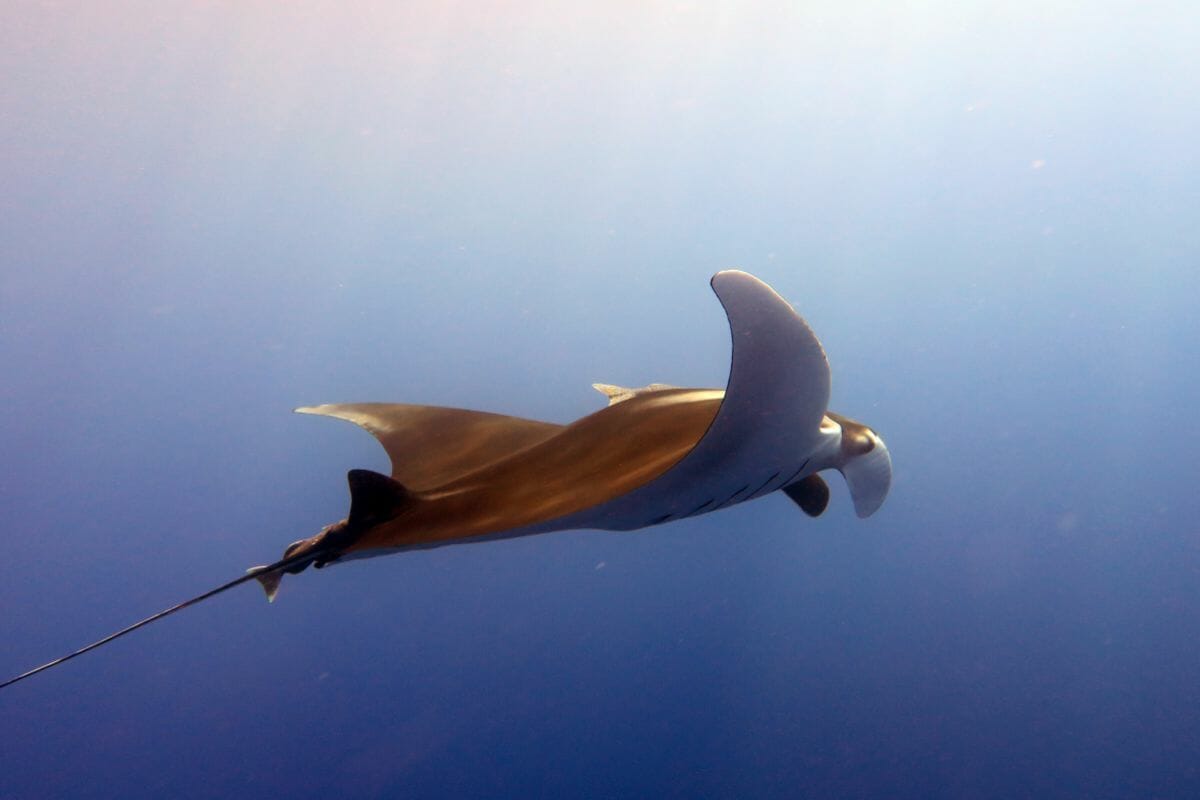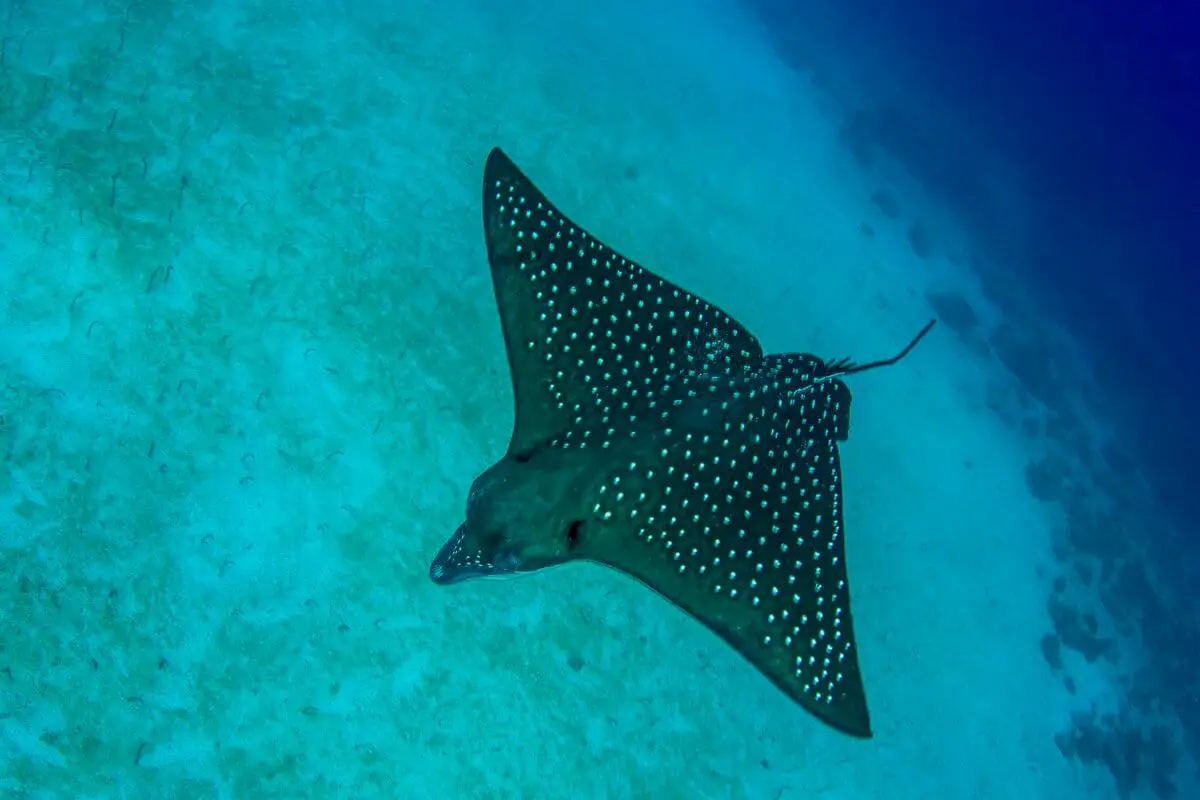Despite their dangerous sounding name, stingrays are relatively docile and non-aggressive.
They tend to swim away when there is a threat approaching.

Distant cousins of sharks, stingrays and many other rays, such as electric rays, the Great Manta and blue-spotted rays, are classed as Batoidea.
Although often called fish, these animals do not actually have bones but cartilage which helps them keep their body shape.
Similar to sharks, they are very widespread across the different oceans of the world, and in different depths, from the sea floor to shallow waters.
While there are over 500 species of rays, we explore ten species of stingray in more detail.
Deepwater Stingray
As their name suggests, these stingrays live in deeper water below 145 feet of the Indo-Pacific.
They prefer rocky underwater habitats, sand seabeds and coral reefs.
Scientists also found deepwater stingrays at extreme depths of 2,560 feet but typically, they prefer the surrounding of slightly shallower water from 900 to 2,230 feet.
With a long tail and a black body color, these deepsea creatures feed on anything they can find at the greater depth, including buried sea worms and fish.
Round Stingray
Also known as stingarees, round stingrays are an entire family covering 35 different species.
They rang in size from 31.5 inches to 5.9 inches.
This is relatively small when you compare them to some other species in the stingray family.
Round stingrays typically have fins that give their body the shape of a diamond, and their brownish color blends in perfectly with their surroundings.
These sea animals live usually on sandy or rocking outcrops in the Western Atlantic Ocean and the Indo-Pacific.
Most of this species stay close to the shore, although researchers also found some round stingrays in depths of 2,300 feet.
Eagle Ray
Similar to the butterfly ray, eagle rays also have their name from the appearance of their winglike fins.
Their serrated spine is sharp and can cause some serious wounds.
These marine animals typically hunt crustaceans and small mollusks.

They usually live on rocky and sandy seabeds but scientists found some of them also nearer the water’s surface.
One of the most impressive member of the eagle ray family is the spotted eagle ray with an impressive wingspan of 7 feet.
American Round Stingray
The American round stingray lives exclusively along the coast of Northern and Middle America, with a large number of species near Mexico.
Similar to other round stingray species, the American counterpart has a deep brown coloration.
Some species even have bright yellow speckles and spots.
Just like most rays, their underside is a faded yellow or white.
American round stingrays have venomous spines at the end of their tail, so they can be dangerous.
Whiptail Stingray
Whiptail stingrays are one of the largest group of stingrays, covering up to 100 species.
They can vastly range in size from just 12 inches, all the way to six feet in width.
Similar to some other stingray species, whiptails also have venomous spines around their tails.
They are serrated and stick out, so they can be easily spotted.
The majority whiptail stingrays live in shallow coastal waters, river mouths and estuaries where they hunt for prey, such as worms, fish, shrimp and crabs.
Freshwater Stingray
Also commonly known as river stingrays, these rays live exclusively in rivers in Southeast Asia, South America, Africa and Australia.
One of the best known members of freshwater stingrays is the Amazonian River stingray which has a round body with a number of black rings and red spots.
Cownose Ray
Part of the eagle ray family, cownose rays can reach a width of up to three feet when they are adults.
They prefer the tropical and temperate climates of the Western Atlantic Ocean where they hunt mollusks, small invertebrates and crustaceans.
These rays have flat teeth that are useful when crushing the shells of their prey.

The name of these stingrays comes from the fact that their pointed pectoral fins run together at the top of their body making it look like a cow’s nose from the top.
Butterfly Ray
Butterfly rays get their name from the position of their fins which are relatively broad making them look like a butterfly from the top.
Although this group only covers twelve ray species, they can have a large variety of coloration, from speckled to spotted.
Some butterfly ray species also have a venomous spine around their tail but the venom isn’t as toxic as with some other stingray species.
Pelagic Eagle Ray
Another fascinating species of eagle ray, Pelagic eagle rays are one of the most striking members of this group.
Its body is covered in white spots on a black background.
Although this stingray cannot really camouflage itself, its appearance is definitely a warning sign to predators.
Their impressive size of up to 16 feet and venomous stingers also add to this effect.
Pelagic eagle rays typically live in tropical regions of the Indian, Pacific and Atlantic Oceans.
One interesting fact that some fishermen have reported is that Pelagic eagle rays do occasionally jump onto boats.
Sixgill Stingray
Most stingrays only have five gills, so the sixgill stingray definitely stands out.
This species has an incredibly pointed snout which it uses to sift through the sediment of the ocean floor hunting for food.
Their protruded jaw then allows them to extend their mouths can catch their prey easily.
While this animal looks a little more unusual compared to other stingrays, it is surprisingly widespread across the Indo-Pacific and the Pacific Ocean.
However, it isn’t spotted very often near the surface as most six-gill stingrays live in depths between 1,500 and 3,500 feet.
Their preferred habitats are rocky outcrops as well as the sandy and muddy seafloor.
Conclusion
Although stingrays have a reputation as fierce and dangerous marine animals, most stingray species live in deep sea waters where they hunt for fish, crabs, shrimp, mollusks and other crustaceans.
- 15 Most Common Animals Living In Ponds - 2024-04-23
- What are the Characteristics Of a Wolf – (Characteristics & Interesting Facts) - 2024-04-23
- Animals That Live In The Abyssal Zone - 2024-04-22








